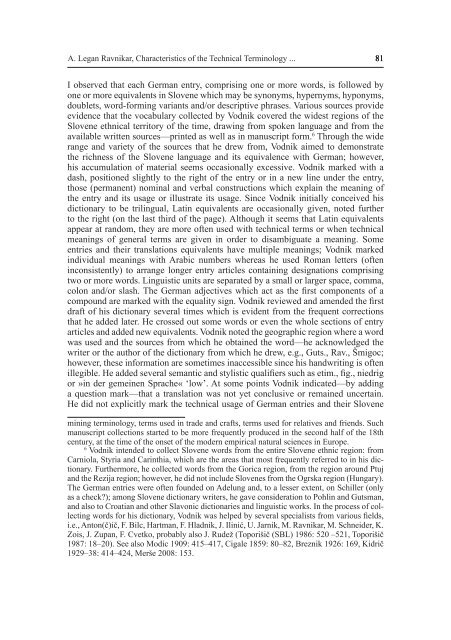Slovenski jezik Slovene Linguistic Studies - KU ScholarWorks
Slovenski jezik Slovene Linguistic Studies - KU ScholarWorks
Slovenski jezik Slovene Linguistic Studies - KU ScholarWorks
You also want an ePaper? Increase the reach of your titles
YUMPU automatically turns print PDFs into web optimized ePapers that Google loves.
A. Legan Ravnikar, Characteristics of the Technical Terminology ... 81<br />
I observed that each German entry, comprising one or more words, is followed by<br />
one or more equivalents in <strong>Slovene</strong> which may be synonyms, hypernyms, hyponyms,<br />
doublets, word-forming variants and/or descriptive phrases. Various sources provide<br />
evidence that the vocabulary collected by Vodnik covered the widest regions of the<br />
<strong>Slovene</strong> ethnical territory of the time, drawing from spoken language and from the<br />
available written sources—printed as well as in manuscript form. 6 Through the wide<br />
range and variety of the sources that he drew from, Vodnik aimed to demonstrate<br />
the richness of the <strong>Slovene</strong> language and its equivalence with German; however,<br />
his accumulation of material seems occasionally excessive. Vodnik marked with a<br />
dash, positioned slightly to the right of the entry or in a new line under the entry,<br />
those (permanent) nominal and verbal constructions which explain the meaning of<br />
the entry and its usage or illustrate its usage. Since Vodnik initially conceived his<br />
dictionary to be trilingual, Latin equivalents are occasionally given, noted further<br />
to the right (on the last third of the page). Although it seems that Latin equivalents<br />
appear at random, they are more often used with technical terms or when technical<br />
meanings of general terms are given in order to disambiguate a meaning. Some<br />
entries and their translations equivalents have multiple meanings; Vodnik marked<br />
individual meanings with Arabic numbers whereas he used Roman letters (often<br />
inconsistently) to arrange longer entry articles containing designations comprising<br />
two or more words. <strong>Linguistic</strong> units are separated by a small or larger space, comma,<br />
colon and/or slash. The German adjectives which act as the first components of a<br />
compound are marked with the equality sign. Vodnik reviewed and amended the first<br />
draft of his dictionary several times which is evident from the frequent corrections<br />
that he added later. He crossed out some words or even the whole sections of entry<br />
articles and added new equivalents. Vodnik noted the geographic region where a word<br />
was used and the sources from which he obtained the word—he acknowledged the<br />
writer or the author of the dictionary from which he drew, e.g., Guts., Rav., Šmigoc;<br />
however, these information are sometimes inaccessible since his handwriting is often<br />
illegible. He added several semantic and stylistic qualifiers such as etim., fig., niedrig<br />
or »in der gemeinen Sprache« ‘low’. At some points Vodnik indicated—by adding<br />
a question mark—that a translation was not yet conclusive or remained uncertain.<br />
He did not explicitly mark the technical usage of German entries and their <strong>Slovene</strong><br />
mining terminology, terms used in trade and crafts, terms used for relatives and friends. Such<br />
manuscript collections started to be more frequently produced in the second half of the 18th<br />
century, at the time of the onset of the modern empirical natural sciences in Europe.<br />
6<br />
Vodnik intended to collect <strong>Slovene</strong> words from the entire <strong>Slovene</strong> ethnic region: from<br />
Carniola, Styria and Carinthia, which are the areas that most frequently referred to in his dictionary.<br />
Furthermore, he collected words from the Gorica region, from the region around Ptuj<br />
and the Rezija region; however, he did not include <strong>Slovene</strong>s from the Ogrska region (Hungary).<br />
The German entries were often founded on Adelung and, to a lesser extent, on Schiller (only<br />
as a check?); among <strong>Slovene</strong> dictionary writers, he gave consideration to Pohlin and Gutsman,<br />
and also to Croatian and other Slavonic dictionaries and linguistic works. In the process of collecting<br />
words for his dictionary, Vodnik was helped by several specialists from various fields,<br />
i.e., Anton(č)ič, F. Bilc, Hartman, F. Hladnik, J. Ilinić, U. Jarnik, M. Ravnikar, M. Schneider, K.<br />
Zois, J. Zupan, F. Cvetko, probably also J. Rudež (Toporišič (SBL) 1986: 520 –521, Toporišič<br />
1987: 18–20). See also Modic 1909: 415–417, Cigale 1859: 80–82, Breznik 1926: 169, Kidrič<br />
1929–38: 414–424, Merše 2008: 153.
















